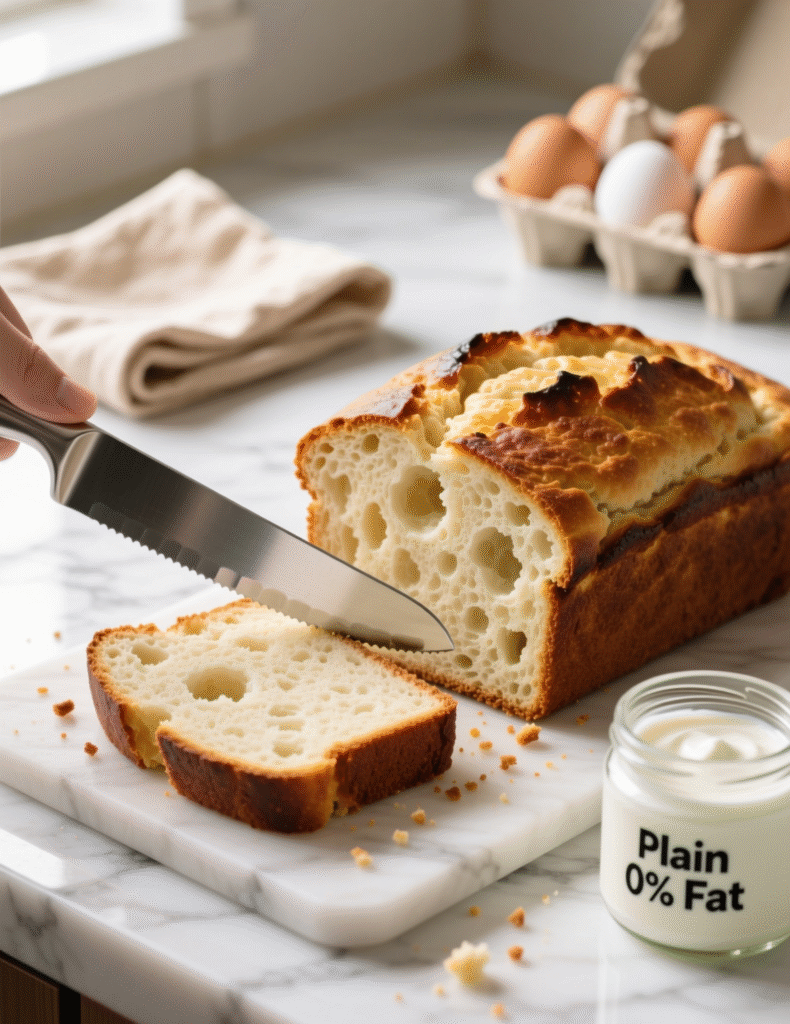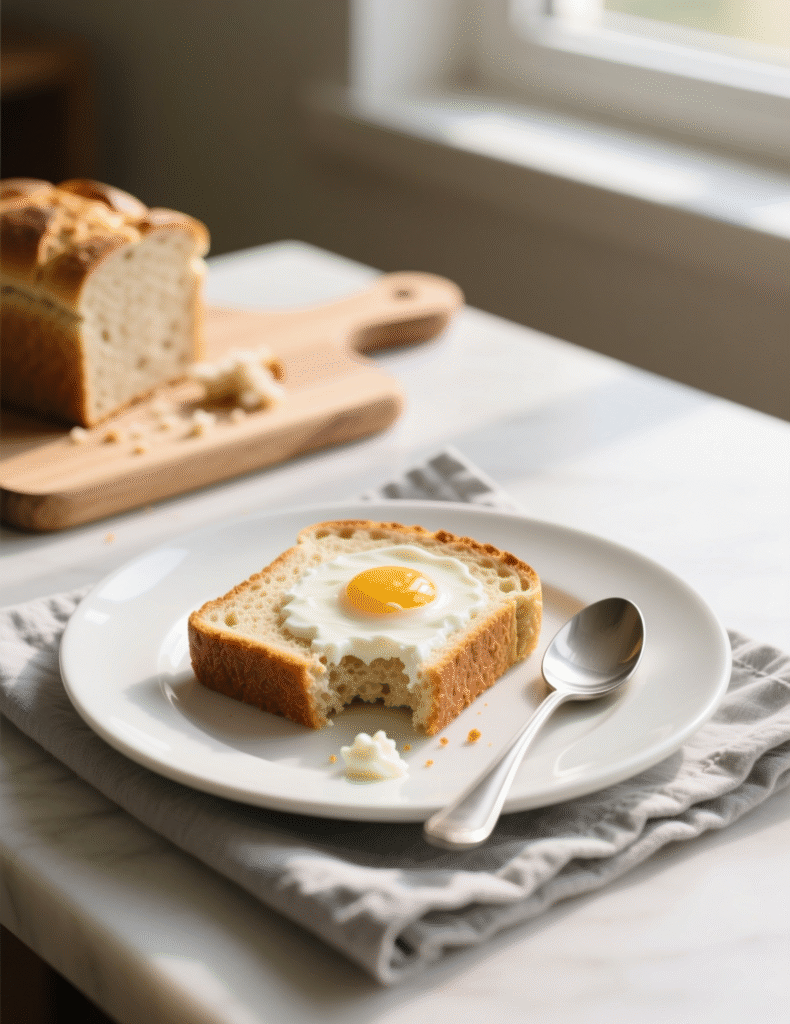There’s something oddly satisfying about making bread that has no carbs. It feels like bending the rules, doesn’t it? Bread, but without the guilt. Without the bloat. Without the carbs that sneak up on you after a cozy breakfast. Today, we’re diving into the marvel that is Zero Carb Yogurt Bread — a surprisingly fluffy, moist, and protein-packed bread made with Greek yogurt and eggs. And trust me, this one’s not your average “diet bread.” It’s legit, flavorful, and has that soft chew that makes you forget it’s zero carb at all.
Why Zero Carb Bread Is Making Waves
Low-carb eating isn’t new, but its sophistication has leveled up. Keto diets, high-protein lifestyles, and blood-sugar control have brought breads like this to the limelight. The idea is simple: replace traditional flour with protein-rich, low-carb substitutes that still create that familiar bread-like texture.
Most zero-carb breads flop—literally. They come out dense, eggy, or taste like… disappointment. But the right combo of Greek yogurt and eggs changes that game. Greek yogurt adds creaminess and tang, while eggs bring structure and rise. Together, they mimic the gluten network in wheat-based breads, giving you something surprisingly close to the real deal.
The Science Behind It
Let’s nerd out for a sec. Traditional bread relies on gluten to trap air bubbles and create structure. Without flour, you need another agent to bind and stabilize. Here, eggs take that role. The proteins in eggs (albumin) expand when heated, forming an airy matrix. Greek yogurt contributes moisture and acidity, which helps denature those proteins in just the right way — so the bread rises but doesn’t crumble apart.
It’s chemistry in your oven, and it works beautifully.
A little fun fact: according to research from the Journal of Food Science and Technology, yogurt in baked goods enhances moisture retention and improves crumb structure — a lifesaver in flourless recipes like this one.

What You’ll Need
Here’s the bare-bones list of ingredients for this easy zero-carb yogurt bread. You probably have most of them already.
- 1 cup Greek yogurt (full-fat or 2%, plain and unsweetened)
- 4 large eggs
- 2 tbsp coconut flour or almond flour (optional, still nearly zero net carbs)
- 1 tsp baking powder
- A pinch of salt
- ½ tsp apple cider vinegar (for lift and flavor balance)
That’s it. You can get fancy with herbs or shredded cheese if you want to flirt with flavor, but this base version works beautifully.
Step-by-Step: How to Make It
Preheat your oven to 350°F (175°C). Grease a small loaf pan or line it with parchment.
In a large mixing bowl, whisk the eggs until they’re slightly frothy. You’re adding air here — this will make the bread lighter. Now, fold in the Greek yogurt until it’s smooth and creamy. It’ll look like thick batter.
Add baking powder, salt, and that splash of apple cider vinegar. The vinegar reacts with the baking powder to give you a little lift. If using coconut or almond flour, whisk it in gently now.
Pour the batter into your prepared loaf pan and bake for 30–35 minutes, or until the top turns a soft golden and a toothpick comes out clean.
Let it cool — seriously, don’t skip this. Like any protein-based bake, it needs time to set. Cut it too early, and it’ll feel a bit custardy. Wait 15–20 minutes, and you’ll have a springy, sliceable loaf that smells divine.
Taste and Texture Notes
Don’t expect a traditional sandwich loaf, alright? This one’s softer, lighter, and has a faint tang from the Greek yogurt that’s oddly addictive. It’s not chewy like wheat bread, but more like a hybrid between brioche and a light quiche. Some folks toast it for breakfast with butter, others use it as a base for avocado toast or garlic bread.
Add a sprinkle of Parmesan before baking, and suddenly, it becomes a savory dream.
Why Greek Yogurt Makes All the Difference
Here’s the thing — not all yogurts are created equal. Greek yogurt is thicker, richer, and higher in protein because it’s strained. That concentrated texture helps bind the batter and gives structure. Regular yogurt tends to be too watery, and your bread will collapse or taste spongy.
A 100g serving of Greek yogurt offers about 10g of protein and less than 4g of carbs, depending on the brand. Combine that with eggs — nature’s perfect protein source — and you’ve got yourself a nutrient-dense, carb-free bread that keeps you full longer than your usual toast ever could.
Nutrition Breakdown (Per Slice)
Rough estimate based on a 6-slice loaf:
- Calories: 95
- Protein: 9g
- Carbs: <1g
- Fat: 6g
- Fiber: negligible (depends on flour used)
That’s impressive, especially when you think of typical bread averaging 12–15g of carbs per slice.
Expert Tips for Perfect Zero Carb Yogurt Bread
- Use room temperature eggs. Cold eggs can make the batter lumpy and prevent proper emulsification.
- Whip well. Air is your secret weapon. The more volume in your eggs, the lighter the final loaf.
- Don’t skip cooling time. The proteins continue to firm up as they cool. Cut too early, and it’ll collapse.
- Play with flavors. Add dill, garlic powder, or shredded cheddar for variety.
- Storage: Wrap tightly and refrigerate for up to 5 days, or freeze slices between parchment.
Real-World Use Cases
I’ve seen keto chefs use this as a flatbread base — bake it thinner and cut it into squares. Works like magic. Some cafes even serve it as a gluten-free option for avocado toast. And it’s a game-changer for diabetics who want to enjoy bread without spiking blood sugar levels.
A 2021 study in Nutrients Journal showed that high-protein, low-carb breakfasts significantly improved glucose control and satiety throughout the day. This bread fits that bill perfectly.
Common Mistakes to Avoid
- Overmixing. It breaks down the airy texture you worked so hard for.
- Using flavored yogurt. It’ll taste weirdly sweet and fake. Always plain.
- Skipping the acid. That vinegar (or lemon juice) helps the baking powder activate. No bubbles = no rise.

Can You Make It in a Microwave?
Actually, yes. If you’re in a rush, you can make a single-serve version in a mug. Just mix 2 tbsp Greek yogurt, 1 egg, 1 tsp almond flour, and ¼ tsp baking powder. Microwave for 90 seconds. Let it rest for a minute, then slice it horizontally for a quick zero-carb sandwich. It’s oddly satisfying, like bread that shouldn’t exist but somehow does.
Variations You’ll Love
Cheesy Garlic Loaf: Add ½ cup shredded mozzarella and a pinch of garlic powder.
Sweet Version: Add a drop of vanilla and a sprinkle of stevia for a breakfast-style loaf.
Herb Bread: Mix in dried oregano, thyme, and a dash of olive oil — heavenly with soup.
You can also pour the batter into muffin tins for mini zero-carb yogurt rolls. Bake for 20–22 minutes and enjoy them warm.
A Few Words on Texture Control
Want it denser? Add one extra tablespoon of coconut flour. Want it lighter? Separate your eggs and whip the whites to soft peaks before folding them in. It’s a small step, but it makes a big difference in airiness.
Also, keep in mind that coconut flour absorbs more liquid than almond flour, so you might need a tablespoon or two of water to balance it out.
Pairing Ideas
This zero carb yogurt bread pairs beautifully with:
- Smoked salmon and cream cheese (brunch perfection)
- Smashed avocado and chili flakes
- Garlic butter and herbs
- Sugar-free jam for a sweet kick
For dinner, it even works as a side for soups, stews, or grilled meats. It’s versatile, subtle, and satisfying — everything a good bread should be, without the carbs that weigh you down.
Expert Insight: The Hidden Advantage
Greek yogurt doesn’t just enhance texture — it supports gut health. The probiotics in live-culture yogurt help balance digestion, which often takes a hit during low-carb transitions. So this bread isn’t just carb-free, it’s gut-friendly too.
That’s a win most keto recipes can’t claim.
Emerging Trend: High-Protein Breads
In 2025, the trend toward functional baking is growing fast. Consumers aren’t just chasing “low carb”; they’re seeking foods that do more — support muscle recovery, digestion, and satiety. Protein-enriched breads like this one check all those boxes.
Several health brands are already developing shelf-stable versions of yogurt-based breads. But homemade versions, with fresh ingredients and no preservatives, always taste better.
Final Thoughts
If you’ve ever missed bread while following a low-carb or keto plan, this recipe feels like a small rebellion. It’s light, easy to make, and nutritionally smart. With only a few ingredients, you can whip up something wholesome that genuinely feels indulgent.
The beauty of this Easy Zero Carb Yogurt Bread with Greek Yogurt and Eggs Recipe is its simplicity. It’s proof that you don’t need flour to make something warm, comforting, and deeply satisfying. Just science, a few humble ingredients, and a bit of patience.
Give it a try, slice it warm, spread some butter, and take a bite. You might just forget it’s zero carb.
FAQs
What makes this Zero Carb Yogurt Bread different from regular bread?
It’s made without flour, using Greek yogurt and eggs to create structure and texture while keeping carbs nearly zero.
Can I use regular yogurt instead of Greek yogurt?
Not recommended, as regular yogurt is too watery and can make the bread collapse or turn soggy.
How many carbs are in one slice of this bread?
Each slice has less than 1 gram of net carbs, depending on the ingredients used.
Is this Zero Carb Yogurt Bread keto-friendly?
Yes, it’s completely keto-friendly and perfect for low-carb diets.
Can I add almond flour or coconut flour to the recipe?
Yes, a small amount enhances texture while keeping it nearly zero-carb.
How should I store the bread?
Wrap it tightly and refrigerate for up to 5 days or freeze slices for longer storage.
Can I make this recipe in the microwave?
Yes, you can make a single-serve mug version in about 90 seconds.
What’s the best way to serve this bread?
It’s great toasted with butter, avocado, or as a base for low-carb sandwiches.
Why does my bread turn out too moist or eggy?
It may need more baking time or cooling; also, ensure proper egg-to-yogurt ratio.
Is this bread gluten-free?
Yes, it contains no gluten and is ideal for gluten-sensitive individuals.

Marie Smith is a passionate recipe blogger, sharing easy, delicious, and creative culinary ideas that inspire home cooks to elevate everyday meals with flavor and simplicity.
